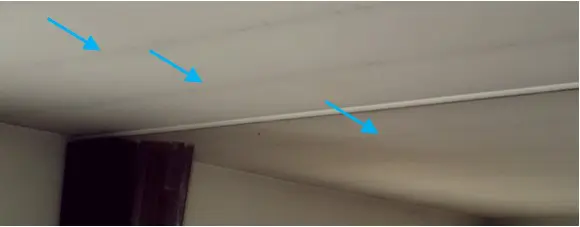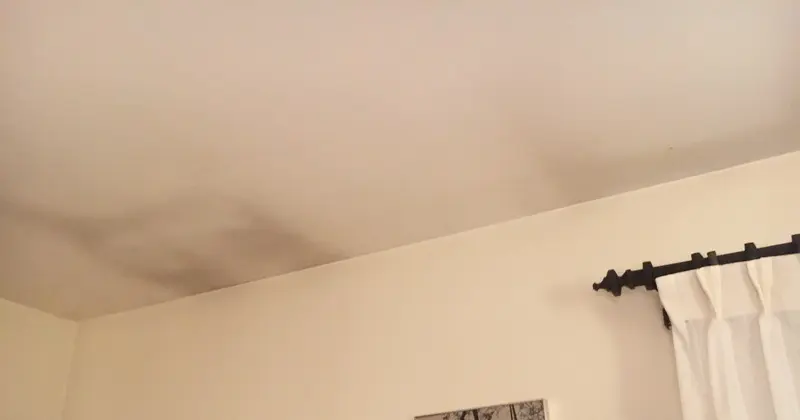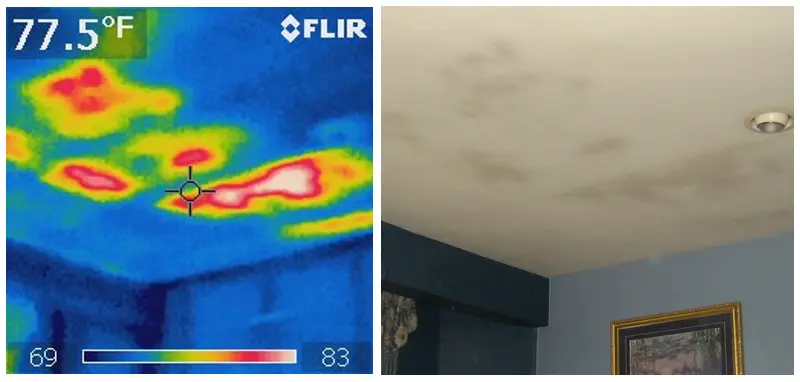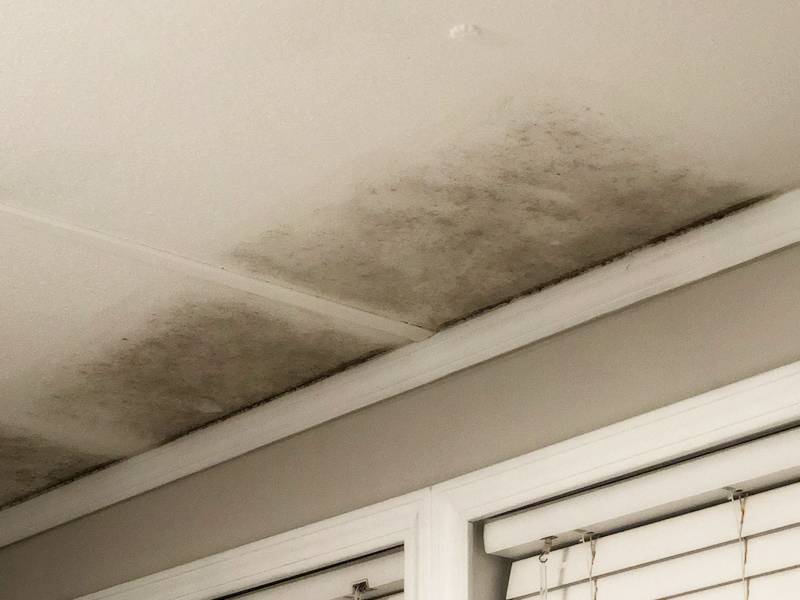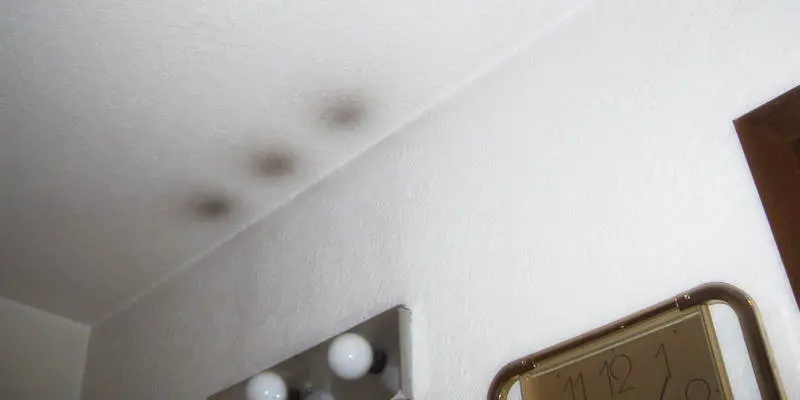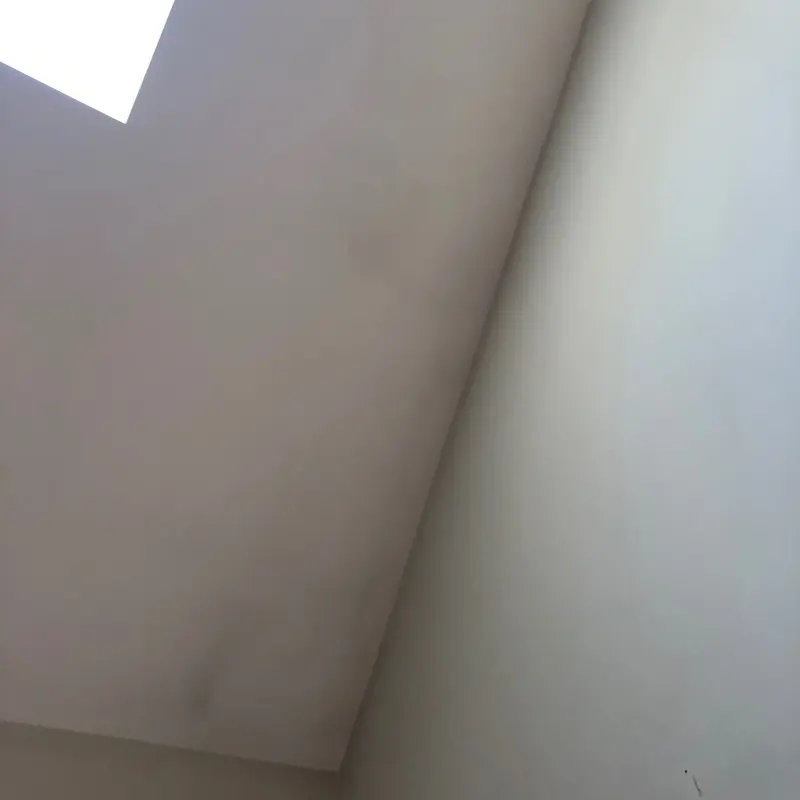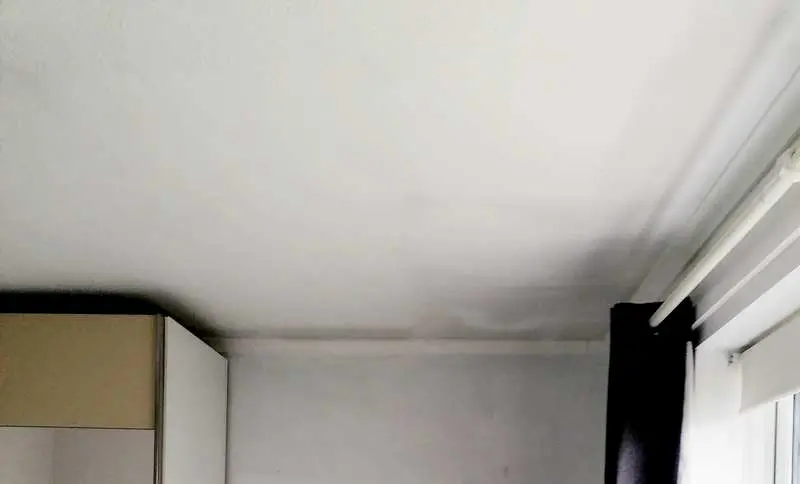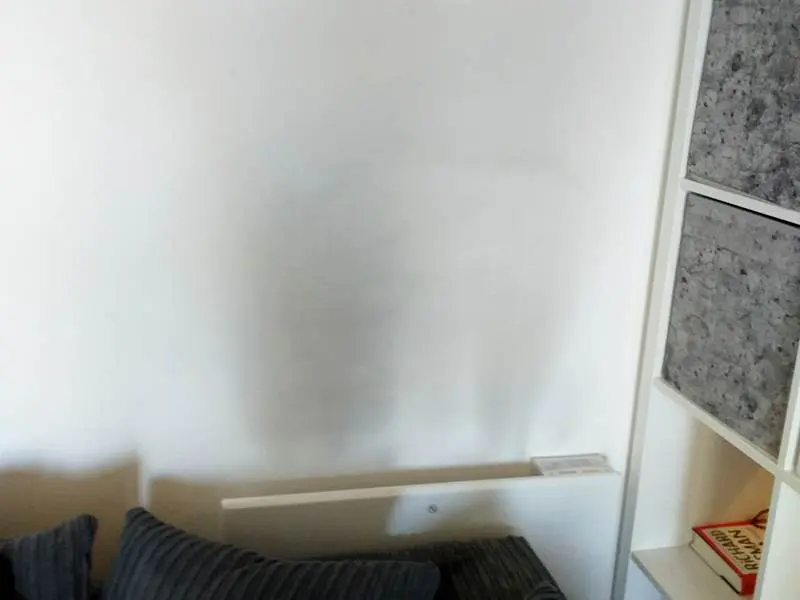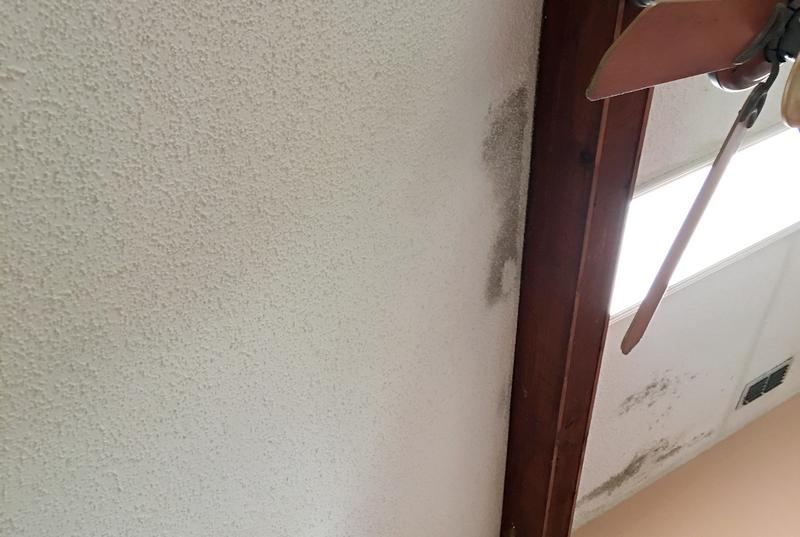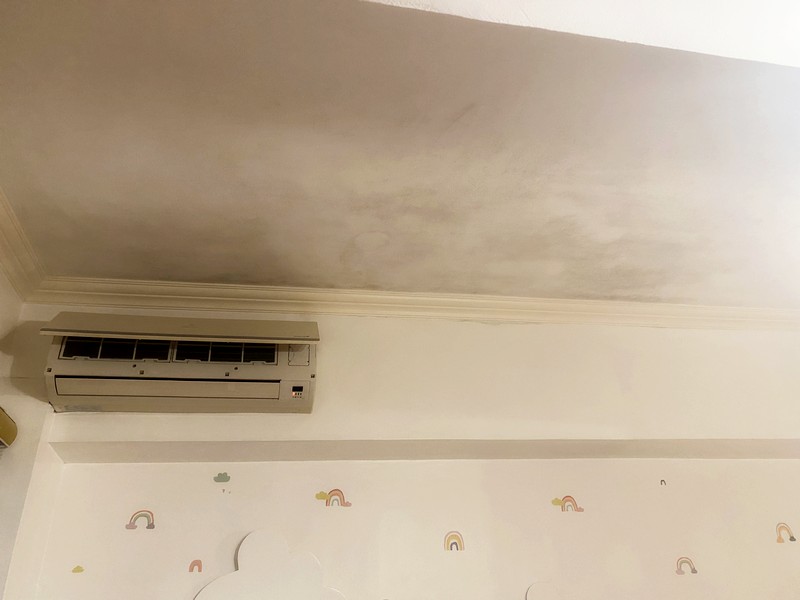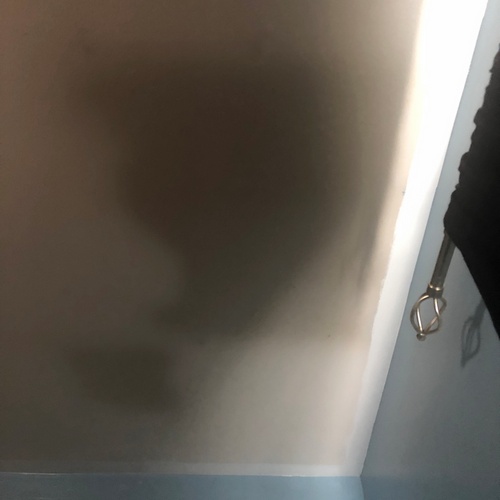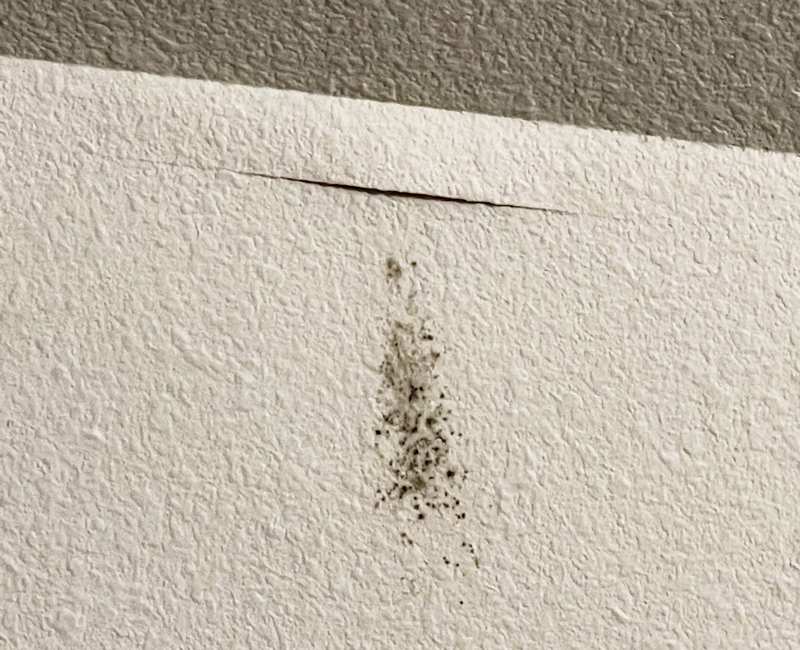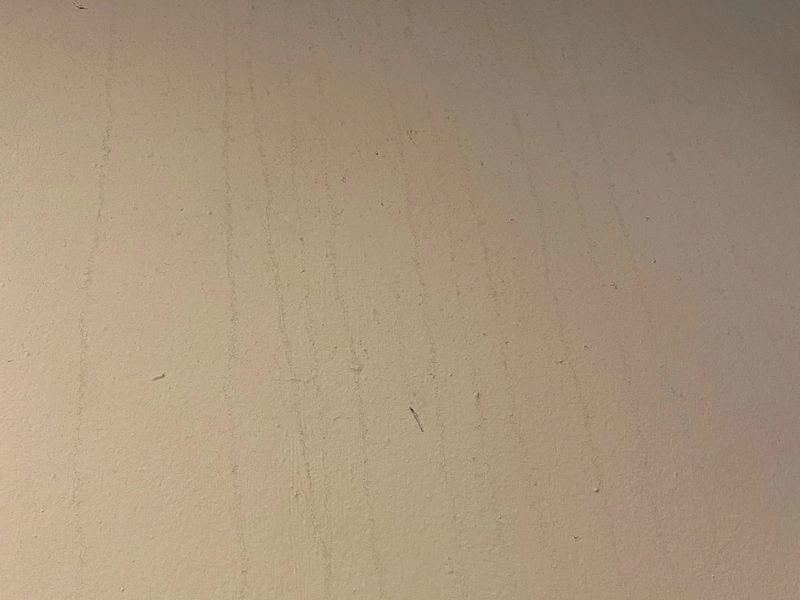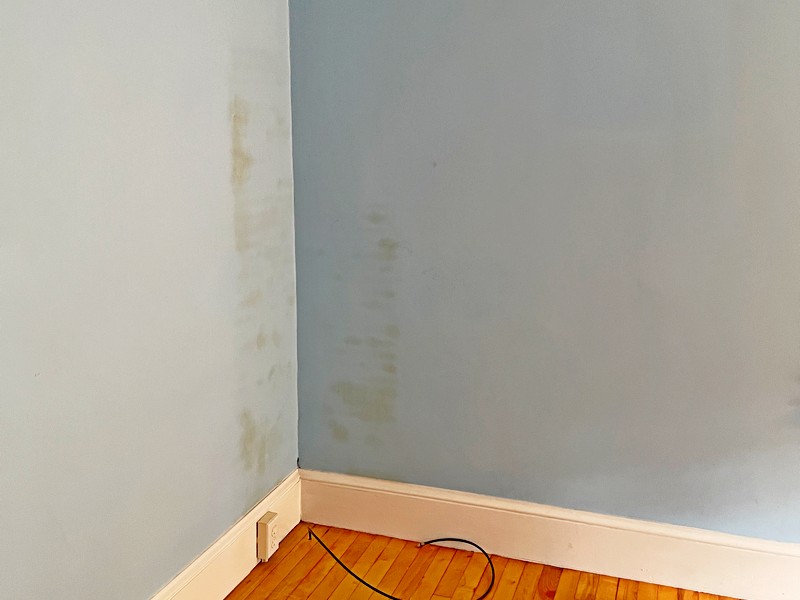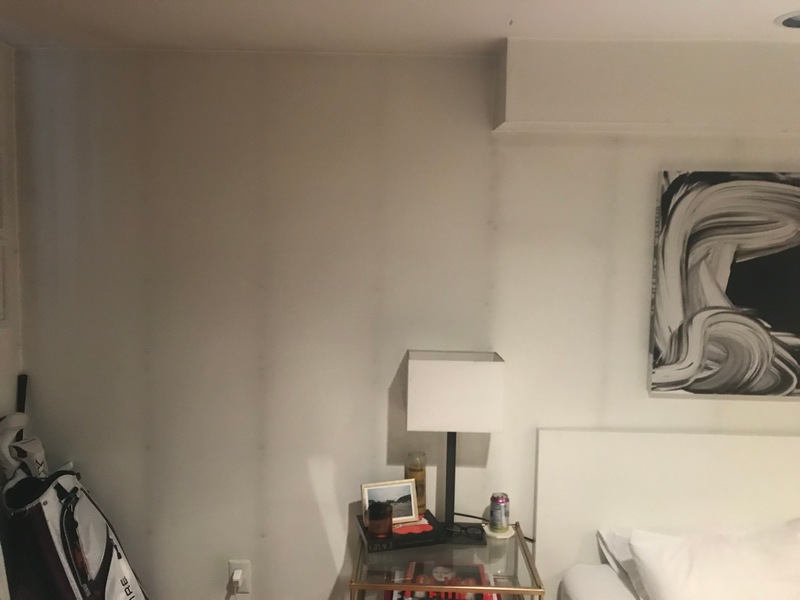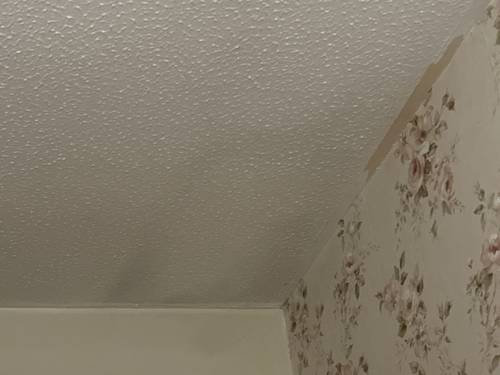Ghosting or Mold Growth?
While interior mold growth on the ceiling is often obvious, there is another building defect that can look eerily similar. It’s called ghosting. It occurs when soot and dust particles stick to the ceiling. Over time, these particles cause a permanent stain. The clue is in the pattern – ghosting often appears in perfectly straight lines.
Why? The lines correspond to the framing in the attic above. Because the framing is a worse insulator than the surrounding fiberglass, a cold spot forms wherever the framing touches the ceiling. The colder temperature leads to condensation, which causes the soot and dust particles to stick.
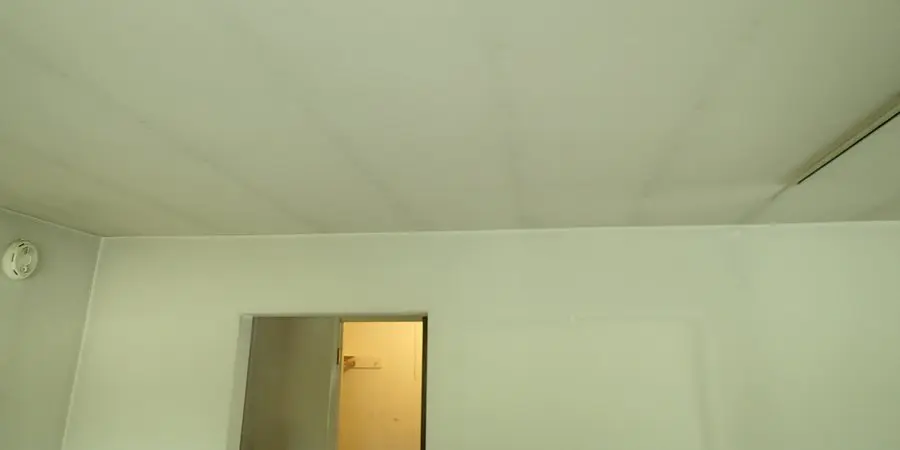
Notice the perfectly straight lines.
Ghosting from lack of ceiling insulation
While ghosting often mirrors the attic framing/rafters, it can also occur due to missing insulation. The photo below is an example of this scenario. Notice how the grey, discolored area matches the exact width of the attic rafters. Insulation is missing in this section, leading to a decrease in temperatures and condensation.
Thermal imaging cameras are excellent at detecting the missing insulation that leads to ghosting. Notice how the colored spots in the thermal imaging on the left match the discolored ceiling on the right. The temperature differences are due to missing insulation (warmer in this case because the inspection was performed in the summer).
Maybe it is mold growth…
In some situations, the same conditions that cause ghosting can lead to mold growth. Notice the angular pattern of the mold in the image below. These rectangular areas of growth line up with the framing in the ceiling cavity. Notice how there’s no mold growth where the framing lines up with the ceiling. This would not occur from a roof leak. The solution is the same as with regular ghosting. Increase the insulation and reduce the humidity.
Lightbulbs
Ghosting can produce other unusual results. Often homeowners will report dark circular spots above vanity lights. This is due to the updraft of air currents created by the heat of the light bulb. As the air moves upward, it carries dust and soot particulates. As the air impacts the ceiling it quickly cools, leaving the dust particulates (and staining) behind.
How do you stop ghosting?
- Stop using candles or combustible oils. In most cases, these are the two culprits.
- Improve your attic insulation. Ensure the insulation covers the ceiling joists/rafter ties. In many older homes with batt style insulation, the tops of the joists are exposed.
- Lower your interior RH. The issue is exacerbated by the excess humidity in the air. If you live in a climate with cool winters, ensure you are properly ventilating your home. Often this can be achieved by simply running a bathroom exhaust fan.
Additional resources
- Excellent explanation on Building Science’s website
*Heads up – I earn a small commission on sales through Amazon links. This helps cover the expense of running the website (and answering your questions!)
Got a question? Ask it here and we'll post the answer below
My walls have green lines on them.
Ghosting typically causes black, not great lines. If you’re observing green growth, this is likely due to mold growth. The same conditions that cause ghosting (condensation, high humidity, etc.) can also lead to mold growth. Purchase a relative humidity gauge and try to keep the RH below 55%. In most climates this can be achieved by simply increasing the ventilation in the home. Running your bathroom 12 hours per day will often do the trick.
Is this ghosting or mold on my cathedral ceiling?
This looks like ghosting. Mold growth typically has a spotting pattern, whereas ghosting has a grey, diffuse appearance. If accessible, check the ceiling from the attic. I’m guessing you’ll find these spots correspond with areas of missing insulation. Lowering the indoor humidity will also help reduce ghosting.
Is this ghosting?
The angular pattern and color are both indicative of ghosting, not mold growth. The ceiling cavity is likely missing insulation, which is causing condensation and ghosting. If accessible, add insulation in the area above the ghosting. If not, focus on lowering the indoor humidity.
Do I need to treat outside before I treat inside ghosting? Also, do the air heaters make it worse?
There is no need to treat the outside first. Ghosting often occurs above radiant or baseboard heaters. As the air is heated, it absorbs moisture from the adjacent areas. The problem occurs when the air cools as it travels upward. At some point it reaches the dewpoint and can no longer hold the water in vapor form. The water is released from the air as condensation. This condensation attracts dust, soot, etc. and causes the visible ghosting. Instead of lowering your heat, focus on lowering the humidity in the home. In most cases this will eliminate the ghosting.
Is this ghosting?
Yes, this growth is consistent with ghosting. A roof leak would not create such a straight line of mold growth. If the attic space above this area is accessible, add insulation to the ceiling cavity. If it’s not accessible, you’ll want to focus on lowering the humidity in the home during the winter months. In most climates this can be accomplished by simply running a bathroom exhaust fan.
The existing mold growth will not fade, even once you solve the underling problem. Repaint the area with a stain blocking primer.
Is ghosting the responsibility of the landlord or the tenant?
This is a great question. In most cases, ghosting is caused by a lack of ventilation and ceiling insulation. Clearly a lack of ceiling insulation is the landlord’s responsibility. However, it rarely occurs in a home with good ventilation.
Does the home have a quiet, effective exhaust fan in the bathroom or laundry room? If so, it’s the tenant’s responsibility to run the fan. The majority of tenants (or landlords) are not aware of this need, so I wouldn’t really call it either party’s fault.
The best solution is to install a programmable timer switch, such as the Air Cycler, to automatically toggle the fan on and off throughout the day.
If there’s no bath fan or it’s old and noisy, it’s the landlord’s responsibility to install a fan or provide another method of ventilation.
There’s one additional factor to consider. Burning candles or incense will heavily contribute to the ghosting.
Is this ghosting?
Yes, this is ghosting / thermal tracking. You need to lower the humidity in the room/house. Purchase a RH gauge and increase ventilation and temperature until you remain under 55%. In many cases, simply running your existing bathroom exhaust fan 24/7 will drop the humidity enough to eliminate ghosting.
Is this ghosting? I took a wet wipe and wiped it and the majority of it did come right off as a brownish color.
The picture is a bit too grainy to determine whether it’s ghosting or mold growth. Either way, the answer is the same – lower the humidity in the home. Both mold growth and ghosting depend on excess humidity. In the winter months, simply increase the ventilation in the home. The simplest technique is to run your bathroom exhaust fan throughout the day. An AirCycler or similar programmable timer switch can toggle an existing fan on and off throughout the day. You’ll want to run it at least 20 minutes per hour.
I have straight lines, looks like a grid. What is the best way to clean the ceiling. I want to paint it.
Paint the area with a high quality stain blocking primer (i.e Zinsser, Kilz, etc.) Finish with a layer of regular ceiling paint. Remember, the lines will return unless you fix the underlying cause.
- Check the attic insulation levels. If necessary, add more.
- Monitor the relative humidity (RH). Your goal is to keep it below 55% (<50% is even better).
- Reduce use of candles, incense or other soot producing products.
Is this mold? Seeing the outer edges of fixtures with dark patterns, actual black dots from a crack in vaulted ceilings and even black hvac filters recently (no candles). There are visible cracks along ceilings and water damage as well but keeps being painted over by landlord even after verifying a leak in roof but no one has checked the crawl space above my ceiling as I requested.
Yes, this is mold, not ghosting. The speckled pattern only occurs with mold growth. Ghosting is much more uniform, almost like a very light grey paint. It also tends to occur in very straight lines.
While this is certainly mold growth, it is not necessarily from a rook leak. High humidity combined with missing insulation could lead to a cold spot. Over time, water will condense on this cool area, leading to mold growth. A moisture meter can verify whether this is the cause.
Hi! Just moved into an apartment and there are these streaks on the wall by the kitchen in the stove. Could it be from a water leak? Should I be worried about mold? The property manager and maintenance team keep telling me not to worry.
This is likely due to humidity. A leak from behind the wall would not cause streaking. The streaking in your photo is typically caused by condensation. If the condensation is severe enough, it will begin to drip down the walls, causing these streaks. Your first step is to ensure you have an adequate range hood/exhaust fan (and you’re using it when cooking). If it’s working correctly and you’re using it, the next step is to lower the humidity in the entire apartment. If the issue primarily occurs in the winter months, you need to bring in more outside air. The easiest way to accomplish this is by running your bath fan. Run it at least 12 hours per day. If the issue is occurring in the summer, your air conditioner is not sufficiently removing moisture from the air.
I just bought a house that has brown-ish "ghosting" and if you smell the wall, it smells like gas. It's on the first floor and there are no pipes going into that wall from the basement. It is an exterior wall. Can we assume there was a propane or other "oil" space heater in this corner?
This is a tricky one. At first glance, this looks like condensation based mold that occurred when a cabinet or other piece of furniture was too close to the exterior wall. This is very common in cold climates. Poorly insulated exterior walls and inadequate indoor ventilation exacerbate the issue. However, the color of the staining is unusual for mold growth. Oils can migrate through layers of paint and cause staining similar to this. It’s possible the previous owners painted over an issue and it slowly leached through.
I recommend painting the area with an oil based stain blocking primer. If the issue is due to leaching from below, the primer will stop it. Note – latex based primers will not work on oil leaching. You must use an oil-based primer.
If the issue returns, install a humidity gauge in the room. Monitor the RH during the winter months and see if it rises above 55%. If it does, take steps to improve the ventilation in the home.
I live in a condo with five units, the windows of one unit have been leaking and there is ghosting in the unit below does extra moisture in the walls contribute to ghosting? The ghosting originally appeared after a very cold snap and the particles were from a heater that broke, but it seems that if ghosting is related to humidity that water in the walls might exacerbate the ghosting.
Good question. It’s unlikely the moisture in the walls would substantially impact the ghosting. If anything, it would typically lead to mold growth. The ghosting is likely related to the cold weather and subsequent condensation on the sheetrock adjacent to the studs. Increase the ventilation in the condo and maintain RH levels under 50%. Also, eliminate any candles, incense, etc. as these greatly exacerbate the issue.
Is this mold growth or ghosting?
Yes, this is very likely ghosting. The rectangular shape of the staining is unlikely to occur with water damage. This ghosting is likely due to missing insulation in the ceiling/attic. If accessible, add insulation to the attic above the ceiling. If there’s no access, your best approach is to lower the humidity inside the home. Replacing your bathroom fan with a constant flow unit (such as the Panasonic WhisperGreen) is often the easiest method to reduce the humidity.

